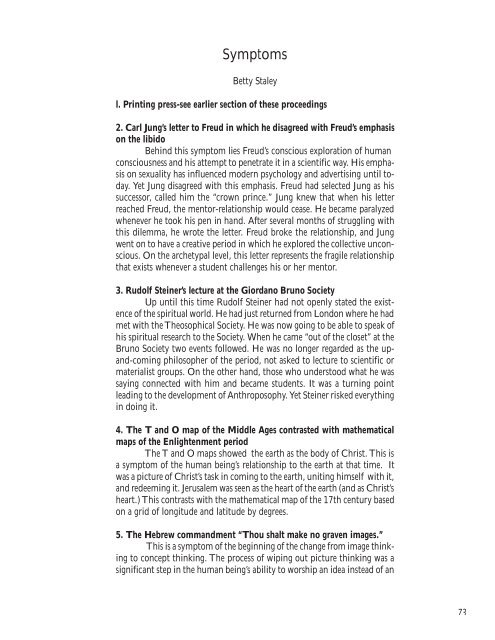Proceedings Colloquium on World History - Waldorf Research Institute
Proceedings Colloquium on World History - Waldorf Research Institute
Proceedings Colloquium on World History - Waldorf Research Institute
Create successful ePaper yourself
Turn your PDF publications into a flip-book with our unique Google optimized e-Paper software.
Symptoms<br />
Betty Staley<br />
l. Printing press-see earlier secti<strong>on</strong> of these proceedings<br />
2. Carl Jung’s letter to Freud in which he disagreed with Freud’s emphasis<br />
<strong>on</strong> the libido<br />
Behind this symptom lies Freud’s c<strong>on</strong>scious explorati<strong>on</strong> of human<br />
c<strong>on</strong>sciousness and his attempt to penetrate it in a scientific way. His emphasis<br />
<strong>on</strong> sexuality has influenced modern psychology and advertising until today.<br />
Yet Jung disagreed with this emphasis. Freud had selected Jung as his<br />
successor, called him the “crown prince.” Jung knew that when his letter<br />
reached Freud, the mentor-relati<strong>on</strong>ship would cease. He became paralyzed<br />
whenever he took his pen in hand. After several m<strong>on</strong>ths of struggling with<br />
this dilemma, he wrote the letter. Freud broke the relati<strong>on</strong>ship, and Jung<br />
went <strong>on</strong> to have a creative period in which he explored the collective unc<strong>on</strong>scious.<br />
On the archetypal level, this letter represents the fragile relati<strong>on</strong>ship<br />
that exists whenever a student challenges his or her mentor.<br />
3. Rudolf Steiner’s lecture at the Giordano Bruno Society<br />
Up until this time Rudolf Steiner had not openly stated the existence<br />
of the spiritual world. He had just returned from L<strong>on</strong>d<strong>on</strong> where he had<br />
met with the Theosophical Society. He was now going to be able to speak of<br />
his spiritual research to the Society. When he came “out of the closet” at the<br />
Bruno Society two events followed. He was no l<strong>on</strong>ger regarded as the upand-coming<br />
philosopher of the period, not asked to lecture to scientific or<br />
materialist groups. On the other hand, those who understood what he was<br />
saying c<strong>on</strong>nected with him and became students. It was a turning point<br />
leading to the development of Anthroposophy. Yet Steiner risked everything<br />
in doing it.<br />
4. The T and O map of the Middle Ages c<strong>on</strong>trasted with mathematical<br />
maps of the Enlightenment period<br />
The T and O maps showed the earth as the body of Christ. This is<br />
a symptom of the human being’s relati<strong>on</strong>ship to the earth at that time. It<br />
was a picture of Christ’s task in coming to the earth, uniting himself with it,<br />
and redeeming it. Jerusalem was seen as the heart of the earth (and as Christ’s<br />
heart.) This c<strong>on</strong>trasts with the mathematical map of the 17th century based<br />
<strong>on</strong> a grid of l<strong>on</strong>gitude and latitude by degrees.<br />
5. The Hebrew commandment “Thou shalt make no graven images.”<br />
This is a symptom of the beginning of the change from image thinking<br />
to c<strong>on</strong>cept thinking. The process of wiping out picture thinking was a<br />
significant step in the human being’s ability to worship an idea instead of an<br />
73
















